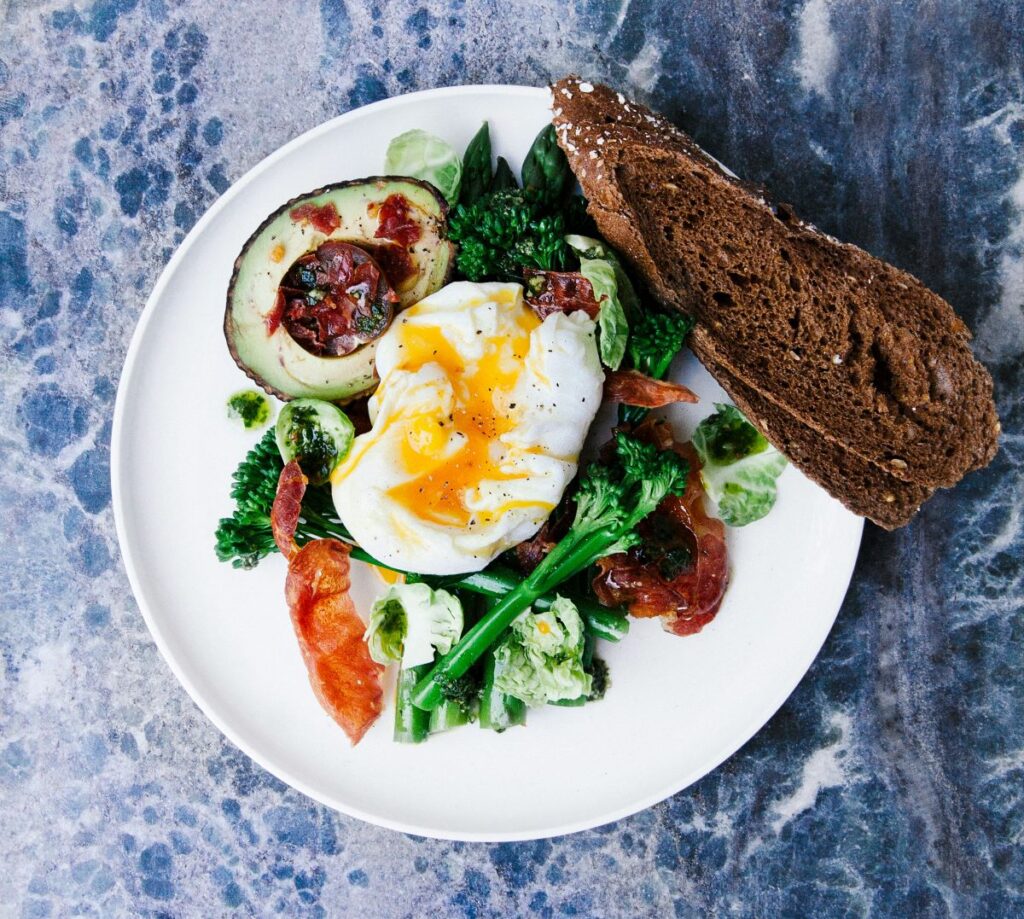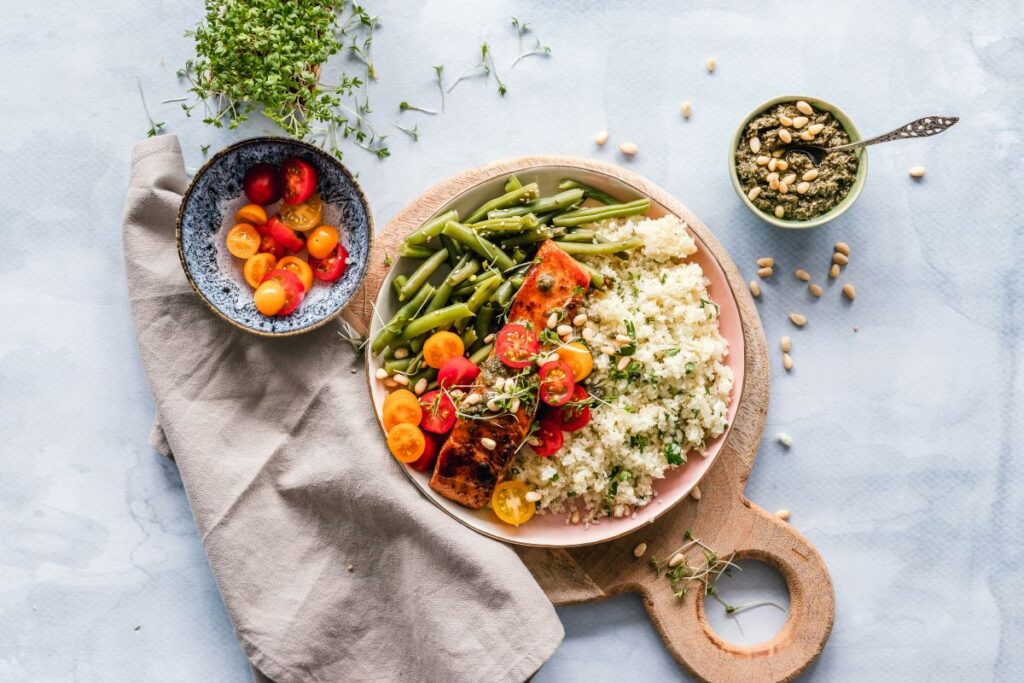You want to choose healthy foods for your family but you’re overwhelmed with conflicting information, the latest diet fad, and news of another food that has the opposite impact on health than we’ve been told for years. I’ve been exactly where you are. I’ve spent years feeling confused and stressed planning and preparing healthy meals. What if I told you that making healthy food choices starts with understanding four fundamental principles? These principles combined with debunking some of the most common food myths, will increase your confidence in making healthy food choices. I’ve also included three practical tips to increase healthy foods in your meals. You can start making changes as soon as your next trip to the grocery store!
A. Food Myths
Many of us are confused about foods that are healthy for us because of all of the conflicting information we’re exposed to daily. In this section, I debunk six highly pervasive and harmful myths.

1. Count Your Calories
We’ve all heard “calories in, calories out”. Just eat less and exercise more and you’ll burn off calories, lose weight and be healthier. But this simple equation rarely holds up, especially for long-term health.
Calories aren’t all equal. This myth can get in the way of eating a balanced, nutritious diet. High quality foods have high nutrient density containing nutrients that are essential for us. 100 calories of salmon are very different from 100 calories of soda. One contains beneficial nutrients like omega-3 fatty acids and protein. The other is high in sugar and lacks nutrients. Eating healthy is not about counting calories. It’s about eating nutrient-dense food.
2. Fat is Bad
Whole populations shifted to low-fat foods, but the switch didn’t make us healthier because we cut back on healthy fats as well as harmful ones. There’s a mountain of new scientific evidence suggesting that the health effects of fats in food are more complicated than previously thought.
Your body needs fats to function. In fact, our brain is nearly 60 percent fat and we’ve learned in recent years that fatty acids are crucial for the brain’s integrity and ability to perform. Good fats:
- Give us energy
- Help our body to absorb certain nutrients (like vitamins A, D and E)
- Give food texture and flavor
- Make food taste good
- Help you feel fuller for longer
- Build cells in your body
- Keep your brain healthy
3. Carbs are Unhealthy
More people are choosing to cut out carbs than ever before. While many diets suggest reducing carbohydrates or cutting them out altogether, they actually play an important role in your health. The trick is to find the right carbs for your body.
Carbs (with the exception of fiber) are your body’s main source of energy. They give your heart, nervous system, muscles, and kidneys the fuel they need to function at their best. And they’re the primary source of fuel for your brain.
Most foods you eat will contain some form of carb and many of them are nutritious. However, not all carb-containing foods are created equal.

4. Breakfast is the most important meal of the day
There’s a lot of debate on the importance of breakfast. As the first meal of the day, “breakfast” literally means to break the overnight fast. Bottom line is that the significance of breakfast varies based on individual preferences, lifestyle, and dietary needs.
Two principles to keep in mind for a healthy breakfast: 1. Eat when you’re actually hungry even if it’s closer to lunch. 2. Have a savory breakfast staying away from sugary cereals, pastries and fruit juices. This promotes stable blood sugar levels avoiding the energy roller coaster associated with rapid spikes and crashes. Blood sugar is an important health and wellness topic that I will cover in future blog posts.

5. Skip the Snacks
Snacks come in all shapes and sizes. It’s not about whether snacking or not is bad for you, but rather how healthy (or unhealthy) your snack is. Opting for nutrient-dense snacks like fresh fruit, nuts, seeds and plain yogurt) will have a significantly different effect on your health than highly processed alternatives like cookies, chips, and candy.
6. Organic produce is always healthier
While organic food is grown without synthetic pesticides or fertilizers, it doesn’t necessarily mean it’s more nutritious or safer than conventionally grown food. Both organic and conventional foods can be part of a healthy diet. When buying fresh produce, two key things to look for are quality and freshness. The best is locally grown produce because it’s typically seasonal and fresh.
B. Healthy Foods Principles
So let’s look at the foods to eat for better health. Food is actually the number one most powerful way you can improve the gut microbiome, help the liver detoxify and support cellular function.

1. Plants First
Fruits, vegetables, whole grains, nuts, and seeds support the gut and are a crucial foundation of a healthy diet. Some of the key benefits of plants are:
- Nutrient Density: This is the amount of nutrients in a food relative to the amount of energy, or calories, it contains. Nutrient-dense foods provide essential nutrients that the body doesn’t make for itself. Plants are rich in essential vitamins, minerals, fiber, and antioxidants. These nutrients are vital for overall health, immune function, and disease prevention.
- Fiber Content: Plants are typically high in dietary fiber, promoting digestive health, regulating blood sugar levels, and contributing to a feeling of fullness.
- Phytochemicals: Plants contain bioactive compounds, such as phytochemicals, that have been linked to various health benefits, including antioxidant and anti-inflammatory properties.
- Heart Health: A plant-centered diet has been associated with a reduced risk of cardiovascular diseases due to lower levels of saturated fats and cholesterol found in many animal products.
- Weight Management: Diets rich in plant foods tend to be lower in calories and saturated fats, making them conducive to weight management and obesity prevention.

2. High-Quality Carbs
High-quality carbohydrates are those that provide essential nutrients, fiber, and sustained energy without causing rapid spikes in blood sugar levels. Low-quality carbs are highly processed and stripped of their naturally occurring fiber and other nutrients. They’re more likely to trigger large sugar spikes which can lead to blood sugar crashes. High-quality carbohydrates include:
- Fruits
- Vegetables
- Whole grains including quinoa: brown rice: oats: barley. buckwheat, millet, amaranth, wild rice
- Legumes including lentils, chickpeas, black beans
- Whole wheat foods including whole wheat bread and pasta

3. Healthy Fats
Healthy fats play a crucial role in supporting overall health and well-being. Incorporating these fats into your diet can have several benefits including hearth health, brain function, nutrient absorption and hormone production. Examples of healthy fats include:
- Monounsaturated Fats: Found in olive oil, avocados, and nuts.
- Polyunsaturated Fats: Found in fish, flaxseeds, chia seeds, and walnuts.
- Omega-3 Fatty Acids: Found in fish, flaxseeds, chia seeds, and walnuts.

4. Lean or Plant Protein
Protein helps with everything from synthesizing hormones and maintaining cell structure to creating antibodies that support immunity. The building blocks of protein are called amino acids. Animal-based proteins contain all the essential amino acids, which is why they’re sometimes called “complete” proteins. Plant-based proteins tend to lack or be low in one or two essential amino acids and are sometimes called incomplete proteins. If you’re not eating animal-based proteins, consuming a variety of plant-based proteins daily can help ensure you’re getting all the amino acids you need. Examples include:
- Lean Animal Proteins: Chicken, turkey, fish (such as salmon, tuna, trout), lean cuts of beef or pork
- Plant-Based Proteins: Beans (e.g., black beans, kidney beans, chickpeas), Lentils, Tofu and tempeh, Edamame, Quinoa, Nuts and seeds (e.g., almonds, chia seeds, flaxseeds), Nut butters with no added sugar (e.g., peanut butter, almond butter)
- Dairy and Dairy Alternatives: Greek yogurt, Cottage cheese, Milk (cow’s milk or fortified plant-based alternatives like almond or soy milk)
- Eggs: Eggs are an excellent source of complete protein, providing all essential amino acids.
- Seafood: Fatty fish (e.g., salmon, mackerel) not only provide protein but also omega-3 fatty acids for heart health.
- Plant-Based Meat Alternatives: Products made from soy, peas, or other plant proteins can be good protein sources for those following vegetarian or vegan diets.
C. Three Tips to Increase Healthy Foods in Your Meals
Eating healthy food doesn’t mean giving up your favorite foods, giving up on flavor or not enjoying what you eat. In fact, doing any of these will mean it’s more likely that you won’t be able to sustain it. Instead, the key is planning meals based on a well-balanced diet of fresh produce, whole grains, healthy fats and lean protein. Simple, mindful changes to your eating habits will lay the groundwork for lifelong wellness. The three tips below are my favorite tips that have helped me make sure we’re eating healthier meals while being less stressed about home cooking and actually enjoy it.

1. Add Instead of Take Away
The more healthy foods you add to your existing diet, the less room you’ll have for less healthy foods, and the more sensitive your palette will become to ultimately appreciate a greater variety of healthy ingredients. You’ll literally crowd out the unhealthy foods until you reach a balanced diet that is sustainable and makes you feel great – even if that still includes an occasional guilt-free indulgence! Here’s how this can be applied in practical ways:
1. Start by eating more vegetables – add 1 vegetable or legume to meals that you’re preparing today.
2. Look for healthy alternatives to your favorite foods – simply, the less processed, the better.
3. Go at the pace that works for you and your family and add more vegetables gradually.
2. Meal Planning
Meal planning can help with maintaining a healthy and balanced diet while saving time and reducing stress. Here are a few tips for effective meal planning:
- Set Realistic Goals: Consider your schedule, cooking skills, and dietary preferences when setting meal planning goals. Start with a realistic plan that you can sustain.
- Create a Weekly Menu: Plan your meals for the week ahead. Include a variety of foods to ensure a balanced diet and prevent monotony.
- Use Versatile Ingredients: Choose ingredients that can be used in multiple meals. For example, roasted vegetables can be added to salads, wraps, or grain bowls.

3. Batch Food Preparation
Batch cooking can save a lot of time by preparing larger quantities of food at once. You’re more likely to put together a healthy meal when it’s already been prepped and seasoned. Some examples:
- Prepare for the week on Sunday by grilling chicken, cooking a box of quinoa, and roasting two pans of vegetables with a swirl of healthy oil, seasoned to taste. Store each component in separate food storage containers in the refrigerator. Now you have large containers of ingredients ready to mix and match throughout the week to keep things interesting!
- Prepare a large batch of soup crammed with vegetables that you can have for lunch or as a side dish for dinner.
Wrap-Up
There it is! My four simple principles to feel confident about healthy eating. We crushed six common food myths and you now have three practical tips to confidently increase healthy foods in your meals. Wondering how different foods affect your energy and can even help you beat exhaustion and brain fog? I’ve prepared a FREE tracker that you can download today. The Energize Your Day Tracker will help you make changes throughout the day so you have more energy for your family and you.
YOU have the power to take the steps to mindfully transform your wellness on your personal journey.
The content provided in this post is for informational purposes only and is not intended to be a substitute for professional medical advice, diagnosis, or treatment. Always seek the advice of your physician or other qualified health provider with any questions you may have regarding a medical condition. Never disregard professional medical advice or delay in seeking it because of something you have read in this post.













Howdy just wanted to give you a quick heads up. The words in your
article seem to be running off the screen in Safari.
I’m not sure if this is a format issue or something to do
with web browser compatibility but I thought I’d post to let
you know. The design look great though! Hope you get the issue
solved soon. Kudos
Hi Maria,
I really appreciate your heads up. I’ll definitely look into it. My website template is designed to adjust to the browser and screen size and works on desktops and cell. Thank you also on your feedback on the design and your kudos. Have a great day!
Great article! I really appreciate the clear and detailed insights you’ve provided on this topic. It’s always refreshing to read content that breaks things down so well, making it easy for readers to grasp even complex ideas. I also found the practical tips you’ve shared to be very helpful. Looking forward to more informative posts like this! Keep up the good work! YouTube Downloader Online
Hi Joel,
Thank you so much for your feedback! You’ve truly captured my intent with my posts to make them informative, easy to understand, and practical. I’m posting more on social media right now (especially Instagram) but applying the same approach to my social media posts as my blog posts. I hope to write more blog posts soon!